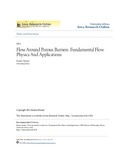Please use this identifier to cite or link to this item:
http://archive.nnl.gov.np:8080/handle/123456789/375| Title: | Flow Around Porous Barriers: Fundamental Flow Physics And Applications |
| Authors: | Basnet, Keshav |
| Keywords: | Motivation |
| Issue Date: | 26-Mar-2019 |
| Abstract: | Investigating flow and turbulence structure around a barrier mounted on the ground or placed in its vicinity is a fundamental problem in wind engineering because of many practical applications related to protection against adverse effects induced by major wind storms (e.g., hurricanes) and snow events (e.g., snow fences used to reduce adverse effects of snow drifting on the roads). In this work the focus is on the case when the obstacle/barrier is porous and the shape of the obstacle is close to a high-aspect-ratio rectangular cylinder situated in the vicinity of the ground. The study employs a range of numerical and experimental techniques to achieve this goal that include 3D LES and 2D RANS numerical simulations, and RTK survey and 3D photogrammetry techniques to measure ground elevations and snow deposits in the field. In the first part of the study, high-resolution large eddy simulations are used to understand the fundamental flow physics of flow past 2D solid and porous vertical plates with a special focus on describing the unsteady wind loads on the obstacle, vortical structure of the turbulent wake, spectral content of the wake, the separated shear layers and of the characteristics of the large-scale vortex shedding behind the plate, if present. Results show that LES can accurately predict mean flow and turbulence statistics around solid/porous cylinders. Then, a detailed parametric study of flow past vertical solid and porous plates situated in the vicinity of a horizontal bed is performed for the purpose of understanding changes in the mean flow structure, turbulence statistics and dynamics of large scale coherent structures as a function of the main nondimensional geometrical parameters (bottom gap for solid and porous plates, and porosity and average hole size of porous plates) and flow variables (e.g., bed roughness) that affect the wake flow. In particular, the LES flow fields allowed clarifying how the interactions between the bottom and the top separated shear layers change with increasing bottom gap and what is the effect of the bleeding flow on the interactions between the separated shear layers that determine the coherence of the large-scale eddies at large distances from the wake. |
| URI: | http://103.69.125.248:8080/xmlui/handle/123456789/375 |
| Appears in Collections: | 500 Natural sciences and mathematics |
Files in This Item:
| File | Description | Size | Format | |
|---|---|---|---|---|
| DrKeshavBasnet_Dissertation_IOE_WRC_PKR.pdf | 19.37 MB | Adobe PDF |  View/Open |
Items in DSpace are protected by copyright, with all rights reserved, unless otherwise indicated.